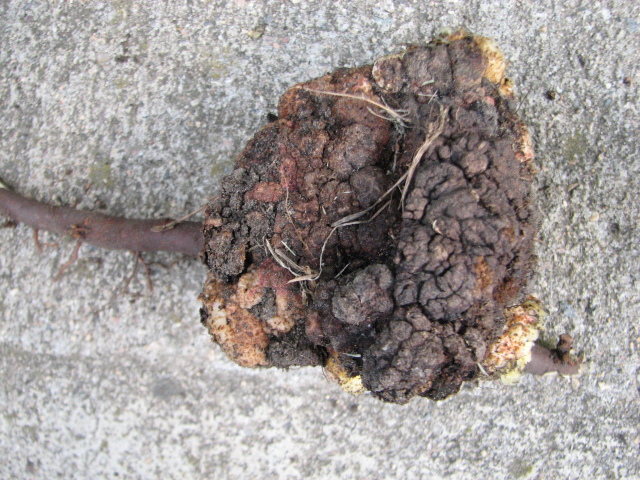Question
 Root growth
Root growth
Hi there,
Our oak tree has developed some orange and red globular spots on the leaves. Also, there are knotty root growth coming up through our lawn. I think the root growths are from the oak, although there are cedars, mountain ash, poplar, and spruce in the vicinity. Is there any treatment for these problems? In my searching on the internet they seem like they may be galls.
Thanks for your expertise!
AnswerThis also is a gall more than likely a crown gall. Crown gall first appears as small round overgrowths on stems and roots. As they enlarge, the galls become woody with a rough and irregular surface. Aerial galls can develop but most are found at or just below the soil line. Galls range from pea-size to larger than 1 foot in diameter.
Crown gall bacteria infect plants through wounds, such as those arising from cultivation, transplanting, wind damage, insect injury, etc. Wounds that have healed beyond a certain point are no longer susceptible to invasion. After establishing itself in the wound, the bacterium transforms normal plant cells to tumor cells. Once this has taken place, the tumor cells are able to reproduce without the bacterium being present. Although crown gall of plants is very much like cancers in humans and other animals, there is no relationship between crown gall and animal cancers. Crown gall has been studied extensively by scientists in their search to understand cancerous growths.
Damage to infected plants results from interruption of water and nutrient movement up the stem. Galls also interfere with normal growth and development, therefore, infected plants may be stunted and unthrifty. With many plants, the amount of damage depends on where the gall or galls are located and how many are present. Death can result if galls girdle the primary trunk or stem. Infected plants are more sensitive to winter injury and drought stress. Control is primarily dependent on prevention. Not much that can be done except keep the trees healthy by fertilizing them with 10-10-10 fertilizer at the rate of 1 lb per inch of trunk diameter scattered around the trunk and watered in good. Apply just before a rain storm and you will nor need to water. I would fertilize this fall and again in the early spring.






